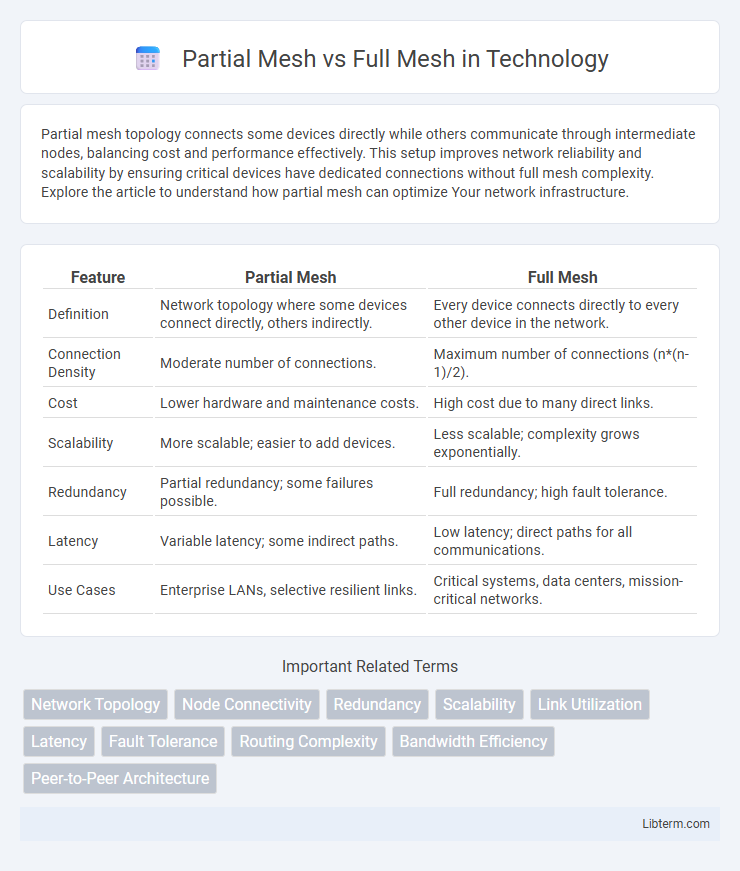Partial mesh topology connects some devices directly while others communicate through intermediate nodes, balancing cost and performance effectively. This setup improves network reliability and scalability by ensuring critical devices have dedicated connections without full mesh complexity. Explore the article to understand how partial mesh can optimize Your network infrastructure.
Table of Comparison
| Feature | Partial Mesh | Full Mesh |
|---|---|---|
| Definition | Network topology where some devices connect directly, others indirectly. | Every device connects directly to every other device in the network. |
| Connection Density | Moderate number of connections. | Maximum number of connections (n*(n-1)/2). |
| Cost | Lower hardware and maintenance costs. | High cost due to many direct links. |
| Scalability | More scalable; easier to add devices. | Less scalable; complexity grows exponentially. |
| Redundancy | Partial redundancy; some failures possible. | Full redundancy; high fault tolerance. |
| Latency | Variable latency; some indirect paths. | Low latency; direct paths for all communications. |
| Use Cases | Enterprise LANs, selective resilient links. | Critical systems, data centers, mission-critical networks. |
Introduction to Mesh Topologies
Partial mesh topology connects some nodes directly while others communicate through intermediate nodes, optimizing resource use and improving scalability in complex networks. Full mesh topology ensures every node has a direct link to every other node, offering maximum redundancy and fault tolerance at the cost of high complexity and cabling. Mesh topologies enhance network reliability and performance through their structured connectivity approaches, with partial mesh favoring cost-efficiency and full mesh prioritizing robustness.
What is Partial Mesh Topology?
Partial mesh topology is a network configuration where some devices are interconnected while others connect indirectly through intermediate nodes, optimizing resource use and reducing costs compared to full mesh topology. This structure ensures critical nodes have multiple connections for redundancy and reliability, while less critical devices have fewer links. Partial mesh balances fault tolerance and scalability, making it suitable for large networks where full mesh would be impractical.
What is Full Mesh Topology?
Full mesh topology is a network configuration where every device connects directly to every other device, ensuring maximum redundancy and fault tolerance. This structure enables high-speed data transmission and minimizes latency by providing multiple communication paths between nodes. Full mesh is ideal for critical systems requiring continuous uptime, though it involves higher installation and maintenance costs compared to partial mesh topology.
Key Differences Between Partial and Full Mesh
Partial mesh topology connects some, but not all, devices directly, optimizing cost and complexity while maintaining moderate redundancy and fault tolerance. Full mesh topology features direct connections between every device, ensuring maximum reliability and minimal latency at the expense of higher implementation and maintenance costs. Key differences include scalability, cost-efficiency, and redundancy, with full mesh providing comprehensive connectivity and partial mesh balancing performance with resource savings.
Advantages of Partial Mesh Topology
Partial mesh topology offers the advantage of reduced infrastructure costs compared to full mesh by connecting only critical nodes, optimizing resource allocation. It ensures enhanced network reliability and fault tolerance by maintaining multiple paths between essential devices, minimizing downtime without the complexity of full interconnectivity. Scalability is improved in partial mesh, allowing easier expansion and maintenance while balancing performance and investment.
Advantages of Full Mesh Topology
Full mesh topology offers superior redundancy by connecting every device directly to all others, minimizing network failure points and ensuring uninterrupted communication. It provides enhanced performance through dedicated links, reducing latency and congestion in data transmission. This robustness makes full mesh ideal for critical applications demanding high reliability and consistent network uptime.
Disadvantages of Partial Mesh Topology
Partial mesh topology presents disadvantages such as limited redundancy and reduced fault tolerance compared to full mesh networks. In partial mesh, some nodes rely on fewer connections, increasing the risk of communication failure if those links go down. This topology can also lead to uneven data traffic distribution, causing bottlenecks and degraded network performance.
Disadvantages of Full Mesh Topology
Full mesh topology requires a significant number of connections, which leads to high installation and maintenance costs, especially as the network scales. The complexity of managing numerous redundant links increases the likelihood of configuration errors and requires more sophisticated network management tools. This topology also consumes more bandwidth and hardware resources, making it inefficient for large or dynamically changing networks.
Use Cases and Applications
Partial mesh topology is ideal for organizations requiring reliable communication with limited redundancy, such as small to medium-sized enterprises or branch offices where cost and simplicity are priorities. Full mesh topology is preferred in critical applications like data centers, financial institutions, and large-scale enterprise networks that demand high fault tolerance, maximum redundancy, and seamless data routing. Network architects select partial mesh for scalable designs with fewer connections and full mesh for robust, latency-sensitive environments needing constant uptime.
Which Mesh Topology is Right for You?
Partial mesh topology offers cost-effective redundancy by connecting only critical nodes, making it suitable for medium-sized networks requiring a balance between reliability and budget. Full mesh topology provides maximum fault tolerance and performance with direct links between every node, ideal for mission-critical systems demanding high availability. Choosing the right mesh topology depends on network size, criticality of applications, and budget constraints, with partial mesh optimizing resources and full mesh prioritizing resilient connectivity.
Partial Mesh Infographic

 libterm.com
libterm.com